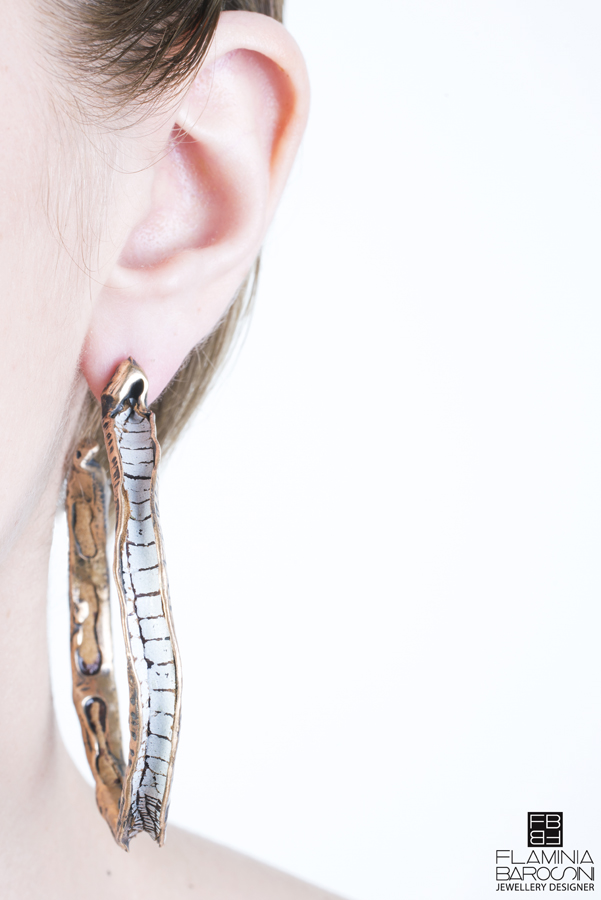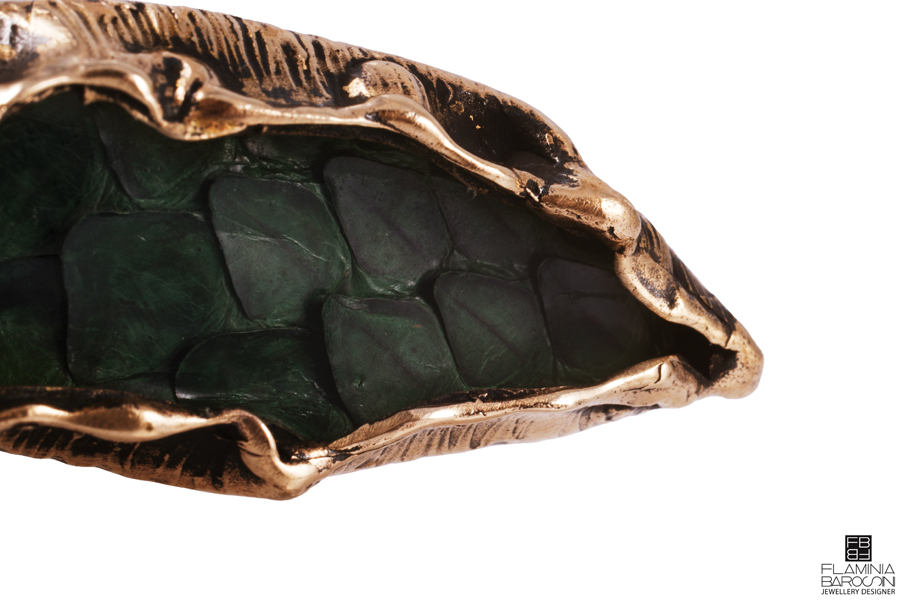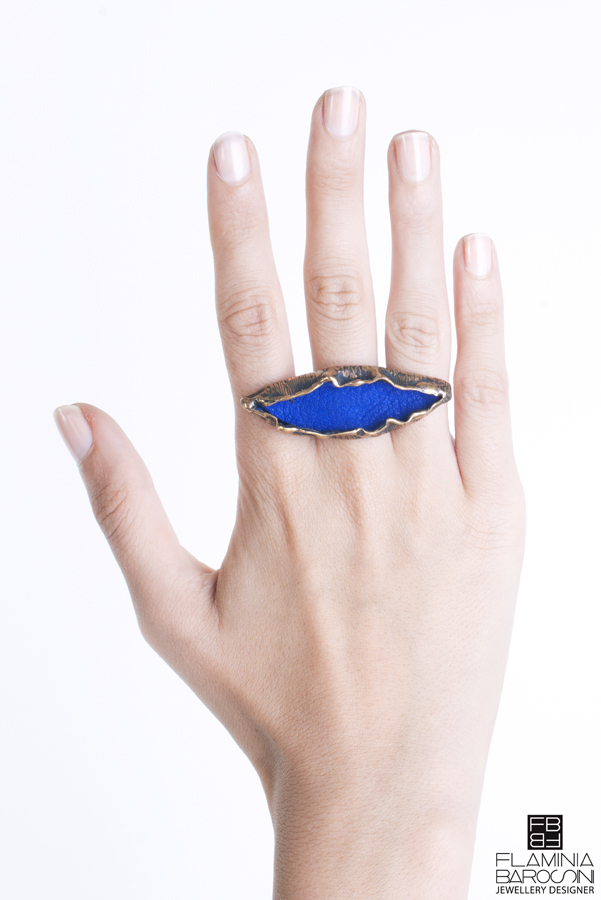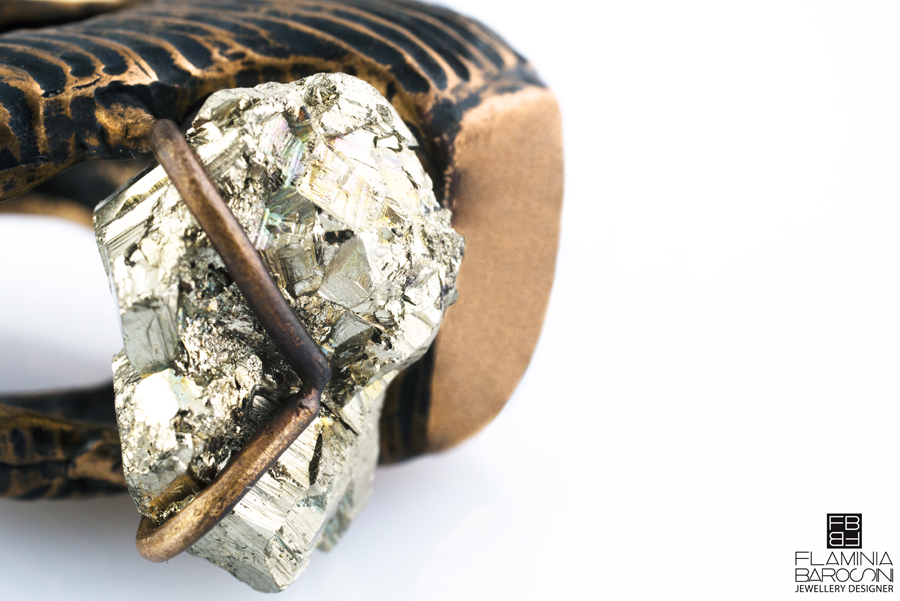I gioielli di Flaminia Barosini nascono dalla passione e dall’entusiasmo di questa giovane designer romana, esuberante e appassionata. Dopo il diploma in Design del gioiello all’Istituto Europeo di Design, prosegue gli studi a Londra presso il prestigioso Central Saint Martins College of Art and Design. Nel 2012 decide di sperimentare la materia, esplorandone le possibilità nascoste attraverso accostamenti di materiali e texture . L’idea può arrivare da un viaggio, da un incontro, ma soprattutto dalla natura che ci circonda.
I gioielli di Flaminia sono delle vere e proprie opere scultoree dalla forte personalità, che prendono forma nel suo laboratorio romano. Tutti i modelli, infatti, sono interamente realizzati a mano, attraverso l’antico procedimento della fusione a cera persa che ne assicura l’unicità e l’autenticità.
Nelle sue collezioni Irregular e Second Skin ogni gioiello nasce dall’incontro del metallo, dell’argento e del bronzo con pellami pregiati pietre e smalti declinati in una ricca gamma cromatica.
Prima di cominciare parlaci delle tue collezioni. Come nascono “Irregular” e “Second Skin”?
Sono sempre rimasta affascinata dalle suggestioni della natura e le sue forme così particolari. Irregular e Second Skin nascono proprio dalla volontà di restituire queste sensazioni attraverso i miei gioielli.
Cosa rappresenta, per te, l’accessorio gioiello? Da cosa trai ispirazione per crearlo?
Credo che il dettaglio faccia sempre la differenza. Il gioiello, da sempre, è simbolo di uno status o di un modo di essere e dietro ha un universo di significati che oggi forse si sono un po’ persi.
E l’ispirazione per le mie linee è sempre strettamente legata al mondo naturale.
Come decidi i materiali da utilizzare per realizzare le tue creazioni? Ce n’è qualcuno in particolare che ami e che maggiormente ti rappresenta?
I tre metalli che utilizzo sono ottone, bronzo e argento: tra questi il mio prediletto è il bronzo, con il suo colore tendente al rossastro. Utilizzo poi una serie di pellami di ogni genere e colore. La razza e il pitone, pellami preziosi, sono i miei preferiti.
Ogni tua creazione è realizzata a mano. Quanto conta per te l’artigianalità?
È la parte più importante del mio lavoro, nessuna macchina può dare a un oggetto l’originalità che solo la lavorazione a mano può dargli. Anche le imprecisioni sono una parte integrante e preziosa.
Nel tuo percorso sei passata dallo IED al Central Saint Martins College of Arts & Design. Quali sono gli episodi che ricordi durante la tua formazione, che ti hanno segnato particolarmente?
Non ci sono episodi salienti, ma posso dire che nell’ultimo anno di Ied ho iniziato a legarmi molto all’arte dell’oreficeria attraverso le lezioni di laboratorio orafo. Da lì l’interesse è cresciuto e ho acquistato banchetto, trapano e tutto ciò che serve agli addetti al settore. Più della progettazione su carta, amo il momento in cui devo creare un prototipo in cera, che poi trasformerò in metallo.
Che tipo di donna immagini quando realizzi un gioiello? Quale è il tipo di femminilità che vuoi costruire e comunicare?
Penso a una donna dinamica e che ama coniugare il classico con il moderno. Una donna che, con nonchalance, riesca a spaziare dall’alta gioielleria al gioiello d’artista.
Chi vuole diventare Flaminia Barosini un domani? Quali sono i progetti che hai in cantiere?
Vorrei diventare una donna dedita al suo lavoro e alla sua famiglia, capace di coniugare con successo affetti e realizzazione personale. Non amo fare progetti a lungo termine, perché mi capita sempre di doverli stravolgere.
“The WalkMan” si pone come obiettivo quello di lasciare spazio e visibilità ai giovani talenti. Cosa ti senti di suggerire a chi ha deciso o sta decidendo di investire la propria vita nella creatività?
Chi è sicuro del proprio potenziale e del proprio progetto deve assolutamente continuare a portarlo avanti, senza fermarsi alle prime difficoltà. Volere è davvero potere.
[divider]ENGLISH VERSION[/divider]
Flaminia Barosini’s enthusiasm, exuberance and passion, drove her to create her jewel collections. After having earned a high school diploma in Jewelry Design at the Istituto Europeo di Design, she continued her studies at the prestigious Central Saint Marting College of Arts and Design in London. In 2012 she decided to test her knowledge by trying different combinations of materials and fine textures. Ideas can arise from trips, encounters, and principally from nature.
Her jewels are just like sculptures that take shape in her lab in Rome. In effect, all the jewels are handmade, through the antique procedure of investing casting. The “Irregular” and “Second Skin” collections are the result of a successful combination of metal, silver and bronze together with upper leather and enamel, used in a very rich color scale.
First of all, tell us about your collections. How was the idea for “Irregular” and “Second Skin” born?
I have always been fascinated by nature and by the particular shapes it offers. “Irregular” and “Second Skin” want to express this sensation through my jewels.
What does a jewel mean to you? Where do you get your inspiration from?
I strongly believe details make the difference. Jewels have always been a status symbol, they represent the way you are and each of them has a meaning that today people are no longer aware of. For what concerns the inspiration for my design, as I said, it mainly comes from nature.
How do you decide which raw material to use for your pieces? Is there one you particularly like and that represents you the most?
The materials I use more often are brass, bronze and silver; among these the one I prefer is bronze especially because of its reddish color. Also, I use different types of leather such as python and upper leather.
Every piece is handmade. How important is craftsmanship to you?
It is the most important side of my job. Uniqueness can only be reached through a handmade work; no machine is able to do it, and imperfections are part of it.
Throughout your academic path you went from IED to the Central Martins College of Arts & Design. Do you remember any significant moment throughout it?
There aren’t any particular episodes to remember. Yet, I can say that I attended a goldsmith’s art course during my last year at IED, and I really appreciated it. Ever since then, my interest for it kept growing and I bought all the necessary tools to be able to operate in the field. However, I must say that I still prefer creating jewel design prototypes in clay rather than on paper.
What type of woman do you think of when you realize your jewels? What kind of femininity do you want to convey through them?
I think of a dynamic woman, who is able to successfully combine classics and modern. A blasé lady whose interest and taste range from fine jewelry to designer’s jewelry.
Who do you want to become? What are your future plans?
I would like to be devote to my job and my family. I also would like to be able to conjugate affections and personal realization. I do not like to make projects for the long-run because something always happens and I am induced to change my plans.
The Walkman Magazine wants to give more visibility to new talents. Would you like to say something to those who, just like you, decide to devote their lives to creativity?
If you are confident about your potential, continue with your projects, and do not quit in front of the first challenges. I think that when there is a will, there’s really a way to reach your goals.
Traduzione a cura di Elizaveta Lo Bianco











